#sakyamuni pagoda
Explore tagged Tumblr posts
Text
August 3rd - Fo Guang Shan Monastery and Museum
I’m giving up on the cough update. It’s still here, it’s not going anywhere, and it sucks. It was another early start. I got up early enough to talk to my friends from home. After I talked to both of them, I got a quick breakfast because we only had 15 minutes to eat. The hot chocolate at breakfast has become my new favorite drink. We boarded the bus and had a long ride to Fo Guang Shan. It is a beautiful and extremely large buddhist temple. I will say though, there are lots of stairs. We got to offer a flower and a prayer to one of the big buddhas and then it was time for lunch. This lunch though was very specific and we had a 30 minute briefing on how to eat it. First, absolutely no phones or talking was allowed. Also, masks had to worn at all times besides when eating. We had to walk in silently, bow to buddha, then quietly pull our chairs back. Then, a chant resumed for about 5 minutes. After this, we could eat. Another part was that we had to eat everything we accepted and since I didn’t know what things would taste like and I can’t finish food if I don’t like it, I had two bowls of plain white rice for lunch. You also only get 20 minutes to eat. Another part that confused me was that there was no beverage served. Eating two bowls of plain white rice with no water is slightly difficult. After 20 minutes was up, another chant resumes, bowls are taken away, and you get to leave and finally break your silence. It was quite an experience, but I will say I do not think I would able to eat every meal like that for years on end. After lunch, we headed to the Buddha Museum. The most interesting part of the museum was the architecture in my opinion. I have never seen such a large statue of buddha. There were gold buddha’s, jade buddha’s, wooden buddha’s, and everything in between. We also got to practice some calligraphy, which was super fun. I was exhausted after all the stairs and walking, so I was excited to get back on the bus and head back to the hotel. Tonight, we get to party with Peter! I think we’re starting at some bars and then maybe a club? Not really sure but definitely excited.
Academic Reflection
Fo Guang Shan was established by Master Hsing Yun and his disciples. The main structures consist of four temples: Daxiongbao, Dabei, Dazhi, and the Dashu shrines. Daxiongbao is the most notable and largest of each of these temples. The main god of worship is Sakyamuni. They believe he was born in 563 or 566 BCE as a wealthy prince. When he realized he was not reaching liberation, he decided to give up his bountiful way of life and turned to meditation in hopes to reach enlightenment on his own. After 49 days of sitting under a tree resisting temptation and urges, he became a buddha. He then spread his wisdom and advocated for a life without need for objects and power. In the temple, there are 14,800 holes of buddha statues. The museum we visited used to be a temple and in 2011, it was transformed into a memorial center with 8 pagodas at the front and the world’s tallest bronze buddha statue.
Citations
https://kagyuoffice.org/buddhism/shakyamuni-buddha/
https://eng.taiwan.net.tw/m1.aspx?sNo=0002121&id=2206
https://taiwangods.moi.gov.tw/html/landscape_EN/1_0011.aspx?i=87


2 notes
·
View notes
Photo

Superb Vintage Chinese Hetian Jade Sakyamuni Buddha Statue & Pagoda w Incense Burner https://www.liveauctioneers.com/item/144199766_superb-vintage-chinese-hetian-jade-sakyamuni-buddha-statue-and-pagoda-w-incense-burner
7 notes
·
View notes
Text
Yingxian Wooden Tower
Postcard from China The Sakyamuni Pagoda of Fogong Temple of Ying County, Shanxi province, China, is a wooden Chinese pagoda. It is also known as the Wooden Pagoda of Ying County. The pagoda stands on a 4 m (13 ft) tall stone platform, has a 10 m (33 ft) tall steeple, and reaches a total height of 67.31 m (220.83 ft) tall; it is the oldest existent fully wooden pagoda still standing in…

View On WordPress
0 notes
Text
youtube
世界最大石灯籠製作 世界ギネス記録認定 念佛宗佛教之王堂 The Largest Stone Lanterns in the world The Buddhist Art of Nenbutsushu
念仏宗無量寿寺(念佛宗) 総本山 佛教之王堂
三国伝来の佛教美術 石灯籠
世界ギネス記録認定 概要 高さ:12m 幅:7.4m Height:12m Width:7.4m 本堂前 左右石灯籠 Stone Lantern The Guinness World Records ギネス世界記録認定 平成二十年四月二十八日 衆生の心を不断の光明で照らし、仏道へと導く。 世界最大の本堂につりあう灯籠を計画すると、灯篭も世界最大になった。
本堂前の二基の灯籠は高さ12 メートル(4 階建の高さ)、世界最大、ギネス世界記録認定となっている。
台座部分には「龍の阿吽形」、「鳳凰の阿吽形」が��刻されている。
本堂 阿弥陀堂
高さ51.5m(基壇、棟飾り込)、桁行(幅)67.9m、梁間(奥行)58.2m 天井までの高さ約32m(11階建ての建物が入る)、天井大彫刻は48畳 破風 一辺25m、合計50m 平瓦 幅1.7尺、奥行1.9尺(世界最大) 十二万四千枚 畳数 888枚 欄間彫刻 堂内488点 柱など堂内は拭き漆仕上げ 上段は六手先総詰組様式、下段は四手先総詰組様式。 上層部に扇垂木を用いた日本建築史上初の佛教建築であり、屋根上に12万4千枚の瓦が敷かれている。 その瓦の波の頂上に聳える鬼瓦は、鬼師・梶川亮治氏制作。 (ギネス世界記録認定・平成19年2月28日公式認証・高さ9m、幅8.8m、先端部経之巻の直径91cm) 鬼の憤怒の形相が、衆生の心中に潜む煩悩を払い、清浄無垢な心を顕現させます。 軒下最上層部の周囲には、手先詰組の間に、釈迦如来像八十体が四方へ向かって遍く衆生済度を勧められ、その下層部には八十八体の龍、蟇股には、表に龍、内に等身大の飛天それぞれ百四体、また、本堂全体で十万枚を超える金色に輝く飾り金具が、荘麗なる浄土の世界を厳飾しています。 堂内には、金箔二重貼り、六手先総詰組、屋根葺面積226.2㎡、総数16,000枚の瓦を使用した宮殿(くうでん)(高さ19m、幅19.98m、奥行12.36m)、その中に在して、大慈悲の光明にて十方世界を照らすが如く輝きわたる本尊阿弥陀三尊佛は、中華人民共和国、工芸美術大師・佘國平佛師制作の総高8.45mの木彫佛像です。 伽藍全体で一万点以上の木彫群、宮殿上に配す幅22.6m、高さ3mの双龍彫刻、宮殿の両脇に四階建てビルの高さに匹敵する全高11mの彫刻が、鳳凰、松竹梅等を刻んで納められている。 また、本堂内壁は、三阪雅彦画伯により、総面積852.9平方メートルに及ぶ金箔襖に色彩豊かに描かれた鳳凰及び瑞雲、また、下部に描かれた蓮華が相俟って、浄土の光景を彷彿させる。
本堂全体で2,987点に及ぶ木彫群、百四十四枚の桟唐戸、また、本堂���に鎮座する一塊の巨岩を彫り込んだ巨大な天水鉢(全高2.2m、幅3.5m、奥行3.5m)等々、世界に二つとない彫刻・工芸の奥深い造形の数々は、どれほどの時をかけても見尽くすことができないものであり、それぞれが調和しつつ、妙なる浄土賛歌を奏でる情景は、参詣する者全てに御佛への畏敬の念を起こさせずにはおかない。
全世界 仏教徒の聖地 「佛教之王堂」念佛宗 総本山 無量壽寺 仏教美術の宝箱 故タイ法王猊下 世界各国の仏教最高指導者 並びに カンボジア王国 故ノロドム・シアヌーク国王陛下の御聖骨がお祀りされている寺院です。 佛教之王堂は佛法に基づいて建立され 建物全ての部位に、仏縁を結ぶ教えが込められています。
伽藍工事全体、およそ7年間で10,524点の彫刻、450,173点を超える彫金が製作されました。
The Royal Grand Hall of Buddhism - Nenbutsushu Buddhist Sect of Japan The sacred place for all Buddhists in the world The Royal Grand Hall of Buddhism
仏教美術の宝箱 Buddhist Art / nenbutsushubuddhistart
念佛宗公式 Official / royalgrandhallofbuddhism https://muryojyu.com
Buddhism has its origin in IndiaBuddhist cultures of China, Korea, and Japan are represented hereat the Royal Grand Hall of Buddhism. It is the first construction of an authentic full-scale Buddhist temple since the erection of the main temple of Obakushu Buddhist Sect in 1661.A total of roughly 3.5 million people joined forces to construct the Royal Grand Hall of Buddhism and completed the entire temple in only seven years without even a single accident.The Royal Grand Hall of Buddhism, in its vast precincts of over 180 hectares, has the Front Gate, the North Gate, the South Gate, the Main Gate, the Washstand, the Ksitigarbha Hall, the Prince Shotoku Hall, the Five-story Pagoda, the North Bell Tower, the South Bell Tower, the Main Halls including the Amida Hall and the Sakyamuni Hall and the Avalokitesvara Hall, the Sutra Hall, the Merit-transference Hall, the Okunoin Hall, the International Buddhist Conference Hall, the Sangha Hall, and the Main Building. All the buildings are decorated with 10,524 sculptures and statues and more than 450,173 metal carvings.
この動画は、個人が念佛宗の資料などを元に作成しており公式なものではありません
#念仏宗#念佛宗#世界一#Guinness World Records#nenbutsushu#buddhist temple#stonecaving#stone lantern#largest#Youtube
1 note
·
View note
Text
TURISIAN.com - Sobat Turisian, ada nih destinasi keren banget buat dijelajahin! DEWI TARI, lokasinya di Desa Rebo, Kecamatan Sungailiat, Kabupaten Bangka, Provinsi Kepulauan Bangka-Belitung (Babel). Gampang banget buat sampe sini, jalanannya bagus dan deket sama kota. Kalo dari bandara juga ga butuh waktu lama, cuma sekitar 30 menit aja pake mobil. Nah, di DEWI TARI ada 4 spot wisata keren yang bisa kamu kunjungin. Yaitu wisata bahari, wisata buatan, wisata religi, dan wisata budaya. Fasilitasnya juga oke, ada homestay, paket wisata, masyarakatnya ramah, dan aman. Bisa jadi tempat yang pas buat kamu buat nge-eksplor dan ngerasain pengalaman yang ga bakalan terlupakan! BACA JUGA: Batik Habangka Akhirnya Lolos ke Ajang API, Gini Ceritanya Wisata baharinya juga gak kalah asik, terutama Pantai Takari. Pantainya punya pemandangan yang cakep, pasirnya putih banget, dan ada pohon cemara yang rapi banget. Cocok buat buat melepas penat dan ngerileksasi diri. Di pantai ini juga ada banyak kerang, jadi kamu bisa ikutan nyari kerang dan ngerasain kegiatan Nyakar yang tradisional banget. Ada juga Pantai Cemara yang lahan pasca tambangnya dikelola dengan baik, dan Pantai Batu Ketak yang punya ikon Morcusuar peninggalan Belanda. Kalo kamu suka tempat buatan, ada destinasi Mutiara Timur yang unik banget. Tempat ini dulunya kolong bekas penambangan timah yang diubah jadi tempat wisata. BACA JUGA: Indahnya Pesona Alam Danau Pading Bangka Tengah Berbagai jenis tanaman hias [caption id="attachment_16372" align="alignnone" width="800"] Pagoda Nusantara terletak diatas ketinggian 356 Mdpl berada di Desa Rebo, Kabupaten Bangka. Foto: Dok.Kemenparekraf[/caption] Sekarang kolong-kolongnya diisi ikan koi dan ikan nila, dan lahan sekitarnya ditanamin berbagai jenis tanaman hias. Jadi bisa buat jadiin spot buat selfie yang keren! Buat kamu yang pengen wisata religi, bisa kunjungin Puri Tri Agung. Tempat ini melambangkan tiga ajaran Tri Darma yang terdiri dari Konfutse (Confucius), Budhisme (Sakyamuni), dan Taoisme (Lao Tzu). Bangunannya megah banget, dan pemandangannya juga indah banget karena deket sama pantai. Selain itu, ada juga Pagoda Nusantara sama Kelenteng Desa Rebo yang asik buat dikunjungin, terutama pas festival budaya. Oh iya, ada juga kegiatan budaya yang seru banget di DEWI TARI! Misalnya, Festival Chit Ngiat Pan atau yang lebih dikenal dengan Sembahyang Rebut. BACA JUGA: Liburan dulu di Pantai Batu Kapur Bangka Selatan! Biasanya dirayakan setiap tanggal 15 Bulan 7 kalender China. Acaranya buat menghormati arwah para leluhur dengan cara memberikan persembahan berupa hasil pertanian di depan altar Thai Se Ja. Dimana, bentuknya kayak patung raja akhirat setinggi 6 meter. Ada juga kegiatan Peh Cun yang seru, bisa coba makan kue bacang atau melempar kue bacang ke laut. Buat umat muslim, ada juga kegiatan Nganggung buat mempererat silahturahmi antara sesama umat muslim. Lengkap kan? BACA JUGA: Benteng Toboali, Peninggalan Bersejarah di Tanah Bangka yang Dibangun 1825 [caption id="attachment_16371" align="alignnone" width="800"] Wisatawan juga bisa menelusuri aliran sungai dengan perahi kano di Dewi Tari. Foto: Dok.Kemenparekraf Tempat Kuliner[/caption] Tempat Kuliner Di sekitar kawasan wisata Dewi Tari, terdapat banyak tempat kuliner yang bisa dicoba. Berikut adalah beberapa di antaranya: Warung Makan Pak Eko Warung makan yang terkenal dengan masakan khas Bangka, seperti mie lendir, luti gendang, dan nasi kuning. Rumah Makan Bahari Menyajikan menu makanan laut yang segar dan lezat, seperti kepiting saus padang, ikan bakar, dan udang goreng mentega. Depot Anugerah Menyajikan aneka kuliner Indonesia, mulai dari nasi uduk, soto, ayam penyet, hingga seafood. Kedai Kopi Bangka Coffee Tempat yang cocok untuk ngopi sambil menikmati pemandangan pantai Takari. Menyajikan kopi lokal dan aneka snack ringan.
BACA JUGA: Berpetualang ke Air Terjun Rembang Bulay Bangka yang Memesona RM Sari Laut Warung makan yang menyajikan masakan laut segar, seperti kepiting saus padang, udang goreng mentega, dan sate cumi. Warung Nasi Bungkus Tempat yang cocok untuk mencari nasi bungkus atau nasi kotak dengan pilihan lauk-pauk yang variatif, seperti ayam goreng, tempe goreng, dan tahu isi. Kedai Makanan Batu Bedaun Tempat yang menyajikan aneka kuliner khas Bangka, seperti mie celor, mie ayam, dan nasi goreng. Warung Makan Sinar Harapan Menyajikan menu makanan Indonesia yang lezat dengan harga terjangkau, seperti nasi goreng, mie ayam, dan ayam bakar. Pastikan untuk mencicipi beberapa kuliner di atas saat berkunjung ke Dewi Tari untuk merasakan pengalaman kuliner yang khas di Bangka. ***
0 notes
Text
Manali:- Paradise For The Wandering Heart

Manali is a hill station nestled in the mountains of Himachal Pradesh at an altitude of 2,050 m (6,726 ft) near the Beas River. It's unfortunate that these amazing destinations we visit have a small minority who thrive to take advantage of innocent tourists that come to provide income for their local economy. Nestled in the mountains, It is a great place to visit all year round in Manali Holiday Package. Kullu Manali, with its picturesque setting in the Himalayas, is a popular tourist destination. There's something for everyone in this area filled with picturesque meadows, pine trees, historic temples, and breathtaking hills.
Places To Visit in Manali:-

Nehru Kund:-
It is a natural spring located on the Manali – Rohtang Pass highway, is a good place to visit during the summers. The source is so-called because Nehru, the first Prime Minister of India, used to visit it during his stay in Manali and drink water from this natural source. The crystal clear waters and calm landscapes of the Himalayas make it a good stop for those heading for the Rohtang Pass in Manali family Tour Package. Needless to say, Nehru Kund is an ideal destination for photographers and nature lovers.
Beas River:-
The Beas River will accompany you for most of your Manali Tourism Package. The village of Vashisht is the best place to enjoy beautiful views of the river valley, but if you visit Kothi you will be closer to its crystal clear waters. The best way to enjoy this river would be to go for river rafting here. For those who just wish to enjoy it from a distance can sit on its banks and witness its gushing milky white waters.

Himalayan Buddhist temple of Nyingmapa:-
The relaxing silence of Manali’s Nyingmapa Buddhist temple will soothe even the most restless nerves. This paradise-like Shangri-La is located in the middle of the bustling city, while its pagoda-style architecture and vibrant hues add mystical charm to the whole. While you’re here, be sure to spin the prayer wheels and admire the Sakyamuni idol and murals. One of the best monasteries in Manali Couple Tour Packages, Nyingmapa is the place where you can connect with your spiritual side.
0 notes
Photo
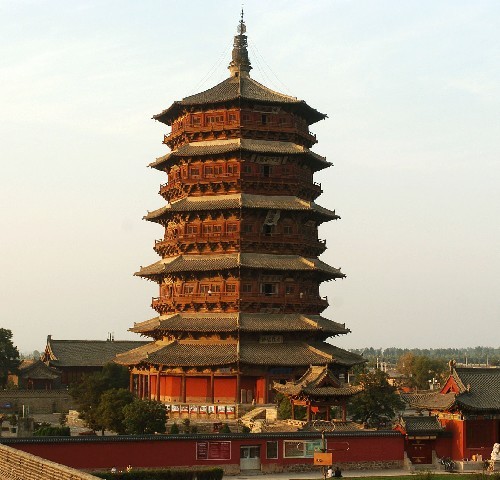
Sakyamuni Pagoda (Fogong Monastery, Shanxi province, China).
6 notes
·
View notes
Text
Dr. Scott and the Nirvana Fish

June 6, 2020
Background
Beomeosa is located on the eastern slopes of Geumjeong Mountain (Geumjeongsan) in Northern Busan. It is considered a head temple for the Jogye Order of Korean Buddhism, representing the Cheongyong-dong district. It is easily one of the Korea's best known and most visited temples.
It was founded and built by the monk Uisang in 678, the 18th year of King Munmu (rule 661-681) of the Silla Kingdom. According to legend, after an attack by Japanese forces, King Munmu had a dream where he was visited by a mountain guardian spirit. He was instructed to climb to the top of Guemjeong Mountain and pray for seven days. After obeying, the guardian spirit would impart his wisdom on how to defeat future Japanese attacks. Both King Munmu and the monk Uisang followed the command, and subsequently defeated the next Japanese attack. To give thanks for the victory, King Munmu ordered the construction of a temple which we know today as Beomeo temple (Beomeosa).
The name Beomeosa roughly translate to "The Heavenly Fish Temple"; Beom (범) = nirvana, eo (어) = fish, and sa (사) = temple. According to another legend, at the top of Geumjeong Mountain there is a well filled with golden water that cannot go dry. Many years ago, a golden fish descended from heaven into the well, giving the water magical properties.
Most of the original Temple site was destroyed during the Imjin War (1592-1598). One exception is the Cheonwangmun Gate (second gate) housing the four guardian kings. Restoration of the temple halls and dormitories was started in 1613 by monks like Ven. Myojeon and Ven. Haemin, and continued for many subsequent years later. One additional hallmark of Beomeosa is the monks training in the famed martial arts discipline sunmundo. This martial art is based on Seon Buddhism; Seon = meditation or zen. Using this training, the monks of Beomeosa famously defeated Japanese invaders during the late 16th century and later as a guerrilla resistance during the Japanese occupation of Korea in the early 20th century.
The Journey
Traveling to Beomeosa was significantly easier than other temples mentioned on my website. The Busan subway line 1 (Orange line) literally has a stop named "Beomeosa", and clear directions from exits 5 or 7 to a special bus (Green, #90), that goes to the entrance.
The actual front entrance of Beomeosa is completely paved for cars and only about 400 meters long. Despite these amenities and scores of Korean visitors, the atmosphere was much more subdued compared to other tourist sites like Headong Yonggungsa or Bulguksa. There were also small pieces of history along the trail instead of vendors and food stalls.

Engraved rock in front of burial grounds.

Engraved rock in front of flagpole support
The Temple Entrance
The main path to Beomeosa entrance takes you through three gates and one large pavilion. Below is the information about each gate provided by displays.
Jogyemun Gate

"The one pillar gate, or mountain gate, is the first of a number of gates built at the entrance to a temple compound. The gate Jogyemun at Beomeosa Temple is renowned as a masterpiece in Korea with its unique style of supporting the roof with four stone pillars. The gate was called a one pillar gate because when viewed from the side it looks as if one pillar holds up the roof. The gate was first built by Venerable Myojeon in 1614, the 6th year of King Gwanghaefun of the Joseon Dynasty (1392 - 1910)"
Cheonwangmun Gate

"The Cheongwangmun (Guardian Kings Gate) is usually the second entryway into the temple compound. It enshrines the "Guardian Kings" of the four cardinal directions for the purpose of protecting Buddha-dharma; North - Vaisravana, South - Virudhaka, East - Dhrtarastra, and West - Virupaksa"




Guardian kings in the second gate. Names of the statues not known.
Burimun Gate

"The Burimun (Non-duality Gate), aka "Liberation Gate", is the last entrance gate to a temple. The term non-duality implies the Middle Way that transcends relative dualities: Being and non-being or birth and death are no different from each other. This gate was newly built during a massive reconstruction of the Bojeru Pavilion in 2012".
Bojeru Pavilion

"The Bojeru Pavilion (Universal Salvation Pavilion) is the largest hall at Beomeosa Temple and most Dharma assemblies and Buddhist rituals are held here. The current pavilion was newly built through a massive reconstruction to restore traditional architecture in 2012"
The Temple grounds
Passing through the Bojeru Pavilion leads to the actual Temple grounds. The initial area is wide open, containing a stone lantern to the left and a three-story pagoda to the right. Around the left perimeter are halls where you can sign up for one of Beomeosa's famous temple stays. Around the right perimeter are actual Temple halls including a bell tower (with a small souvenir shop underneath), Mireukjeon Hall (Maitreya or future Buddha), and Birojeon Hall (Vairocana or all-seeing Buddha).

Three-story pagoda (right side of courtyard)

Stone lantern (left side of the courtyard)
Looking straight ahead, there are three sets of stairs leading to the Daeungjeon Hall housing the statue of the Sakyamuni Buddha and two observant Bodhisattva (past, present, and future). On this higher level are smaller halls such as the incense pavilion (far right), Gwanneumjeon Hall (Avalokitesvara or Bodhisattva of compassion, right of main hall), Ksitigarbha Hall (left of main hall), Mountain God Shrine (further left), and the combination of Palsangjeon Hall (Paintings of the eight great events from Shakyamuni Buddha's life), Dokseongjeon Hall (Ven. Naban shrine), and Nahanjeon Hall (Shakyamuni Buddha and 16 Nahans or holy disciples).

Beomeosa is always filled with people, so getting in position for pictures was kind of hard. I decided not to take that many pictures or videos of the inside of any Hall with people praying. You can check out the few pictures and videos I got at my website.
The Future
Beomeosa was definitely one of the best temples I've visited since being in Korea. Despite being so close to civilization and always filled with Korean tourists, Beomeosa maintains a peaceful and tranquil atmosphere. The wisteria fields and Geumjeong Mountain trails are also large enough to spend a whole day exploring. After the typhoon season, I plan to revisit Beomeosa to check out their Buddhist museum (currently closed for repairs and probably COVID-19) and walk to one of the many hermitages (settlement for Buddhists to live) for additional pictures.
Check out more pictures on the main pages of the website. Follow ag4abroad on Steller, Flickr, and Instagram for updates.
사랑해!
4 notes
·
View notes
Photo

Art of the Day: Portable Buddhist Shrine

Pilgrims and itinerant monks used portable shrines for worship and teaching. In the central panel, the historical Buddha Shakyamuni (Siddhartha Gautama, ca. 563–483 BCE) preaches a sermon while surrounded by disciples, donors, and guardian deities. Above, a celestial Buddha from the distant past listens to the sermon from a three-storied pagoda. At the bottom, four musicians flank a stupa, a sacred mound or architectural structure that safeguards a relic of the Buddha or another venerated being. On the left and right doors, the bodhisattvas Manjushri and Samantabhadra are on their animal mounts. Below them are the 16 disciples of Buddha Sakyamuni, referred to as "arhats" in Sanskrit and "lohans" in Chinese. Learn more about this object in our art site: http://bit.ly/2RFItNy
13 notes
·
View notes
Text
Gyeongju Day 2
Day 1
For our second day in Gyeongju, we rented a car because we were going to visit some places that were fairly far away from the city and from each other, plus, Gyeongju doesn’t have a subway system, there aren’t many buses and taking a taxi all the way there would be very expensive. So, as you can clearly see the best option was renting a car, however, instead of going to dealers, or car rental shop we used this app called SOCAR, i had seen a few cars in the local parking lot that had a sticker that said “socar” but i never really paid attention to them until that day where i learned that its a short-term car-sharing service and everything you need to do can apparently be done on the app, no need to deal with anybody, and as a person that is extremely shy i thought this was amazing. I don’t really know how it worked because my husband was the one that did everything, but from what i gathered you download the app, log-in and then you can book the car, when you’re ready to use it you can just pick it up at whatever parking lot it’s at and you can unlock the car with the app, i don’t really know how to explain since i didn’t use it myself and i was much too distracted worrying about the Aux cord to ask questions but i found this other blog that can help.
Anyhow, after taking a few pictures of the car just in case we set off to our first destination, though we had two stops before we really headed to the place, first we stopped at the McDonalds drive-thru for our morning coffee and then to Daiso to buy a few things we needed for the day, like hot packs, an aux cord, and a blanket (now that i mention Daiso i think i should make a post about it) After we had everything we needed, then we finally headed our way.
Bulguksa Temple.
After an hour or so we arrived at our first destination, Bulguksa Temple. When we arrived we parked the car which has a fee between 500won to 2.000won depending on the type of car, you also have to pay an entrance fee Adults pay 5.000won and from there teenagers and children pay less. i was actually a bit taken aback by the number of people there was since it was a Tuesday and we’re not on vacation period so seeing so many people was surprising. there were children on a field trip, some western tourists, and tour groups of Japanese tourists and other groups of Chinese tourists and even groups of Koreans, i found this a bit amusing since i noticed that aside from the children, the few western tourists and a few other young people here and there most of the tour groups were made up of older people, something that repeated itself at every other Temple we visited that day.
When you first enter through the first set of gates you are welcomed by a dirt path surrounded by trees, and since we’re in Autumn the trees had beautiful shades of red and yellow and some of them being a bit stubborn were still a little green. To your left, there’s a small pond with and if you continue going that way you’ll find yourself in the car park, and next to the entrance on the right, you’ll find the bathrooms, which i believe are the only bathrooms on the property but i could be wrong. Now, when we entered we had to wait for a little bit because i big group of what i would guess middle school children were making their way out and as children normally tend to do where being a bit rowdy and taking all the space on the main path. After the cheers and yells died out we continued on the path they had come from, to our left was what seems to be a new building for made for the Temple stay experience.
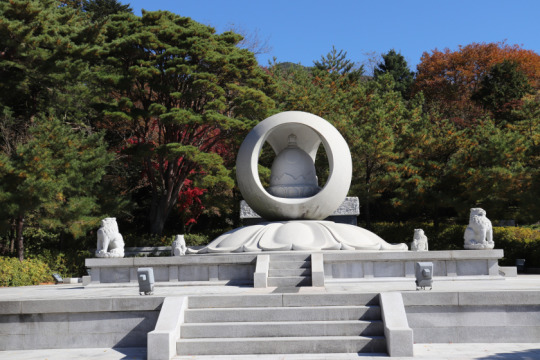
we looked around for a bit and then crossed a beautiful bridge over to the “Main Gate” of the Temple. At first i just thought it was like any other ancient door, but as we went through i noticed that on the two inner walls stood two giant statues (two for each side) I don’t know what they were since i am fairly ignorant on Buddhism, especially when it comes to deities, but i think at least from their poses and expressions they must be guardians.
From the door to the temple it doesn’t take much, but if you’re like me you will definitely get sidetracked but the little stalls selling souvenirs and Religious artifacts (?) however i didn’t take long looking at them since my husband said we couldn’t buy the little sword, why they sell a mini sword is beyond me but it was cute. We then were faced with the Breathtaking view of the Temple stairs. They’re these huge stone steps that go all the way to the top of the temple and were lined with beautiful potted flowers. According to my husband, these steps are the original ones and haven’t been restored. I don’t know how true that is since the Korean Tourism website they say that the temple has been destroyed and reconstructed multiple times be it from fires or war, however, they make no mention of the steps, but the Temple’s website does say they were built in 751 and have been in continuous use until they were closed off to the public to preserve their already fading characteristics.
Then we officially entered the Temple, it’s a beautiful place, imagine Gyeongbokgung since it follows the same architecture and layout as most Korean ancient structures but much more colorful. The red and yellow of the walls and the beautiful paintings on the roof are mesmerizing. the inside of this first hall had a magnificent golden Buddha, as most buddhas are. you aren’t allowed to take pictures inside the rooms so you’ll just have to go and see it for yourself since whatever description i can give will do it no justice.
on the outside, there are these two huge stone pagodas. One of them is called Dabotap and the other one is called Seokgatap, according to the temples official website they are Korea’s two most renown pagodas.
“The two pagodas were built at the same site to reflect the content of the Saddharmapundarika Sutra (The Lotus Sutra), in which the Dabo Buddha (“Buddha of the past”) stands beside Sakyamuni (“Buddha of the present”) to prove that his Buddhist sermon is right.” -temple website.
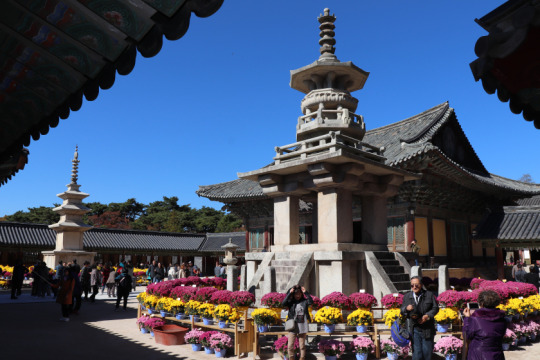
Dabotap pagoda certainly catches one’s eye at once due to its unique shape, varying from the more traditional structure Seokgatap and most pagodas have. Because of this people aren’t entirely sure how many stories it has. It is a beautiful structure, it has so many different shapes and structures within its self yet the still look so harmonious and pleasing.
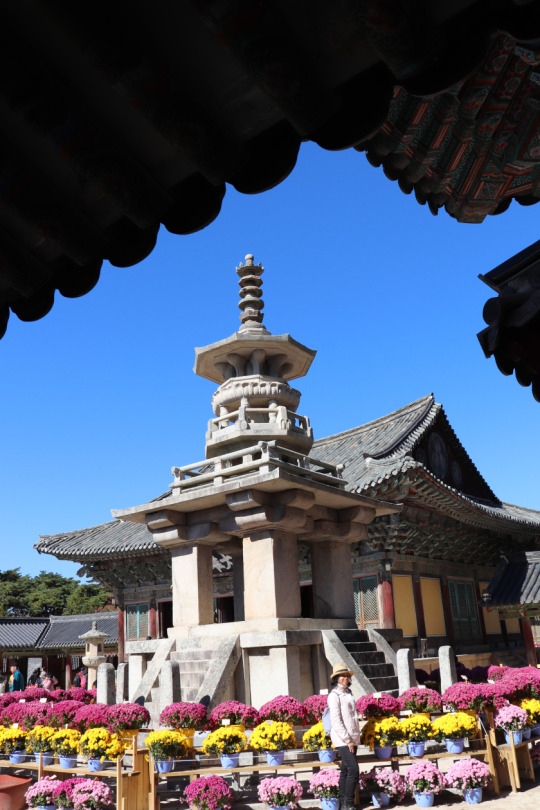
Seokgatap is a more traditional and simple type of pagoda, but that doesn’t mean it’s any less beautiful. The Pagoda from its construction many centuries ago remained in near perfect conditions until 1966 where robbers damaged the structure, i assume they were looking for reliques that are often stored inside the stone, luckily when they were repairing it the right people found multiple artifacts and reliques now deemed national treasures like the pagodas themselves. I definitely recommend reading the website since it has amazing historical facts.
After this main hall, we followed the rest of the temple’s layout each as beautiful as the one before. We spent a few more minutes looking around and admiring the scene but alas we had to move along to the rest of the places we had planned for the day.
Seokguram Grotto.
At the top of the mountain, almost a 40-minute drive from Bulguksa temple where all you really see is the mountain full of trees, all changing color, especially the gingko trees golden yellow and cascading like a shower of gold flakes. Aside, from the autumn scene, it was all so reminiscing of Colombia, with its lush green mountains and winding roads. We arrived at a parking lot, paid the entrance fee and walked through a small forest path we arrived at a small crook in the mountain where we found ourselves facing two small temple-like buildings hidden by the trees. We made our way to the uppermost building where you can see the Buddha of Seokguram grotto. Unfortunately, you can’t take pictures inside but is such a magnificent view. It’s a huge Buddha made of stone, everything is made out of stone, carved with such amazing detail.
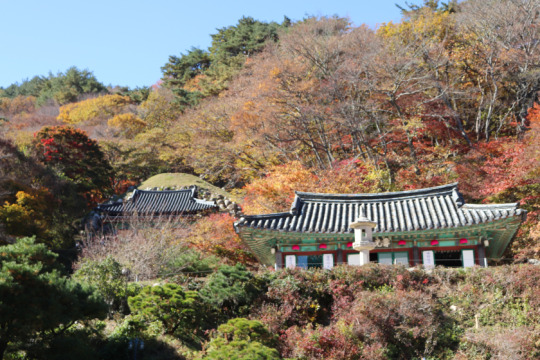
Aside from the amazing masterpiece that is the Buddha, the view from this place is simply breathtaking, i didn’t realize how close we were from the ocean.
The other buildings were a prayer hall, a souvenir shop, and a bathroom.
Golgulsa Temple
Located at the foot of Mt. Hamwol, Gulgulsa is the only temple cave in Korea. The temple was built out of solid rock during the 6th century by Saint Gwang Yoo and some accompanying monks, and was designed according to the architectural structure of India. –Visit Korea
Our Third stop was a small temple i convinced my husband to go to since it isn’t actually one of the bigger more popular temples, on the contrary, it’s a small and very private temple nestled in between the forest. the place is smaller than any other temple we’ve been, it feels more private and it is much less “touristy” feel than Bulguksa or other temples we visited. This place first caught my attention because on the map we had the picture they displayed had monks doing martial arts, this is the first time i see something like it on any temple, but then when doing some research on it aside from its peaceful setting and the Buddha Carved on the side of a mountain, they had a statue of a dog that used to live there, this made me want to go even more.
The entrance was lined with statues of monks in various martial art positions, i didn’t get a chance to take a picture of them because on both our way in and out i was preoccupied eating some pound cake since at this point we hadn’t had anything to eat all day and i was starving.
The first few buildings you encounter i assume since we didn’t go in, seem to be the study halls for the monks and participants of the Temple stay, and imagine the cafeteria.
After a short walk up a hill, we were met by two statues. one was Buddha and the other of a dog.
The Dog was called Donga or Monk Donga, he was born in the winter of 1990 and since he was a puppy he dutifully followed the monks on their prayers, he also loved people and helped guide them to the temple, and contrary to his breed’s natural behavior -he was a Jindogae, and they apparently are used for hunting and guarding- he never hurt another living creature. He was such a good dog that when he died in 2010 the human monks made him a statue so he could reincarnate as a human. I got a bit choked up as i pet his statue.
Then we went to the prayer halls and caves, they are all located on the side of a small mountain. the first hall you encounter is where the monks perform their martial art, then as you continue up the stairs you will see different little grottos carved into the rock.
At first, as we went up the main stairs i was fine, but then to get to the Maya Tathagata Buddha the path got more precarious as we had to actually climb up the rock walls while holding on to the safety ropes which are very high up for someone who is extremely afraid of heights. the Maya Tathagata Buddha is magnificent, carved out of the rock by hand.
Unfortunately, when we got there, we were too high up for my comfort and i immediately sat down on the prayer platform which i don’t think was appropriate but i was too terrified to move and this seemed like the safest place to be. i was too scared to even look up at the Buddha and was only able to look down at the platform banks while my husband took the pictures.
Tomb of King Munmu (Great King Rocks)
A few minutes drive from Golgulsa temple through the countryside we arrived at the beach to visit our next sight, the tomb of King Munmu. King Munmu was the first 30th king of the kingdom of Silla responsible for unifying the three kingdoms (Baekje, Silla, and Goryeo) hence becoming the first King of great Silla. You would assume that such great historic King should have a huge tomb made in his name, yet, if you didn’t know what you were looking for you’d just see a bunch of rocks of the coast.
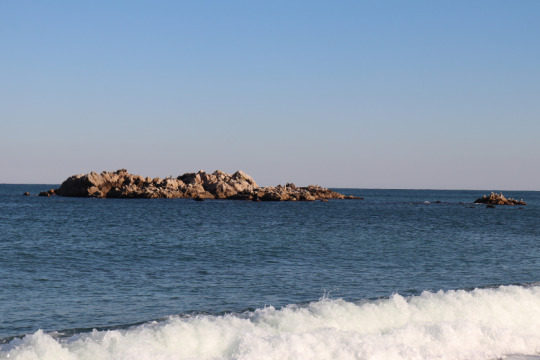
The Tomb of King Munmu is an unassuming group of rocks, close to the shore, that to the unknowing just seem like home for seagulls, but if you look closely to you will notice that on top of the biggest rock there’s what seems like a marble tombstone, i don’t know for sure what it says but it must have the King’s name. you see, According to the legend King Munmu gave instructions that after his death, he should be buried at sea where he could become a Dragon to protect Silla from Japanese invasions.
The rocky island, about 200m in circumference, is divided by a cross-shaped waterway, forming a pool at the center, at the bottom of which is a granite stone 3.6 meters long, 2.9 meters wide and 0.9 meters thick. Legend has it that the remains of King Munmu’s cremated body are buried under this rock. Historians still debate whether the ashes of the King Munmu were scattered or stored in an urn and placed under the rock.- Visit Korea
Following a few photos of the tomb, a few pictures of us and a quick history lesson from my husband, we walked along the beach just looking at the water and taking in the view, since aside from the tomb there isn’t anything else of particular significance other than a few seafood restaurants. We walked for a bit when we saw a group of grandmothers/old ladies, three sitting together, one sitting behind them to the right and another a little farther away to the left, at first i just thought they were having a picnic at sea or just sunbathing, but then i noticed the one to the right was banging a drum, the one to the left seemed like she was crying or pleading and the three in the front where all praying and bowing. I quickly realized they practice all Korean religion, the original religion before Buddhism or any other, also known as Shamanism. It was the first time i saw this in real life, only seeing it before in movies or shows so it was a bit surprising, just because it’s something so unknown to me.
Columnar Joint Zone of Yangnam.
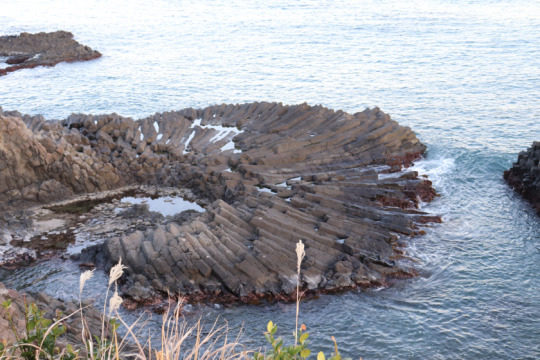
Our second to last Sight was the columnar joint zone of Yangnam, Its a geological formation caused by a pool of lava that got cooled down int’ its present shape. It looks like piano keys or steps, this particular one is called buchae the Korean word for the hand fan since the circular shape of this formation makes it look like a half-opened hand fan.
Gameunsaji Temple Site
Not far from the Tomb of King Munmu, but in the middle of seemingly nowhere, where all you can see are mountains, farmland, and the highway you will find the Gameunsaji Temple site. However, all you will actually see are the pagodas because nothing remains another than these huge three-story stone pagodas. The temple was ordered to be constructed by King Munmu, whose purpose was to have a place where he could pray for Silla’s guidance and protection from invasions. He died before they finished its construction but his son King Sinmun completed and named the temple in honor and respect for his father.
We stayed in the parking lot in front of the pagodas waiting for the sun to fully set so we could both see the pagodas lit up against the darkness of the night and because we wanted to see the stars, something we don’t get to do in Seoul but here, in the middle of nowhere, it was perfectly dark for stargazing.
Woljeong bridge.
When we got back to the city we made one last stop, Near the royal tombs there is a beautiful covered bridge called Woljeong, i don’t know anything about it since i only saw pictures of it, and since it was a bit dark and cold we didn’t walk up to it. All i know is that it was built sometime during Silla, it was destroyed and rebuilt and now its closed off to the public which just means you can’t cross over it, you can only admire it. next to the bridge there’s a traditional village where you can rent a hanbok and take pictures in traditional looking homes, a restaurant and a very cool looking Cafe, but due to the time it was already closed and the cafe although visually very inviting we weren’t in the mood for coffee so we didn’t bother going in.
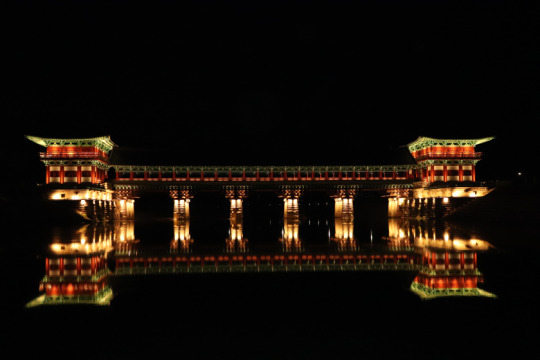
I took many pictures of the bridge but sadly we couldn’t last long because it was cold and because we were hungry again so we headed back to the hotel and look for somewhere to eat dinner.
Despite the fact that we arrived relatively early, actually, at around 7 pm we noticed that every restaurant and was either about to close or closed already. we drove all over the place trying to find somewhere to eat, without any luck. we even went to hansot – a homestyle fast food restaurant- that earlier that day we had noticed closed at 9 pm but when we arrived at 8 pm on the dot, the lady was already closing, our only to options at that time was either McDonalds or convenience store food, and given that my husband was already tired of Mcdonalds we at the convenience store which compared to American 7/11 it’s actually pretty good because they sell lunch boxes that come with rice, and vegetables and whatever type of protein you chose, so even though we were a bit disappointed we still ate very well and understand that not every city is like Seoul where people tend to eat very late so restaurants close very late, so if you ever go to Gyeongju just keep in mind that if you want to eat at a specific restaurant you should go before 7pm.
And that was how our day ended, with a belly full of quick food and tired from a day of exploring.
*All pictures are taken by me and are not edited.
To The South, Second Day. Gyeongju Day 2 Day 1 For our second day in Gyeongju, we rented a car because we were going to visit some places that were fairly far away from the city and from each other, plus, Gyeongju doesn't have a subway system, there aren't many buses and taking a taxi all the way there would be very expensive.
#Asia#beautiful#Buddha#Buddhism#East Asia#expat#fun#History#Korea#Korean History#Life#living abroad#living in korea#nature#photographs#sea#south korea#travel#traveling#Visit Korea
4 notes
·
View notes
Photo

在藏传佛教中,如果说布达拉宫代表太阳,那么扎什伦布寺就代表着月亮。寺内香炉紫烟升腾供台灯火闪烁,五百多年来吸引着国内外众多佛教信徒,是中国藏传佛教的格鲁派寺院。信步其间,殿宇毗连,金顶红墙,大殿里僧侣诵经井然,佛像前信徒顶礼膜拜。寺中错钦大殿可容 2000 人诵经,殿中有释迦牟尼像,两边有根敦主与四世班禅立像。大殿两侧为弥勒殿与度母殿。寺的西侧有大弥勒殿,高 30 米,甚宏伟。另有历世班禅灵塔殿,藏舍利肉身。 In Tibetan Buddhism, if the Potala Palace represents the sun, then the Tashilhunpo Monastery represents the moon. Temple incense burners purple smoke rising for Taiwan lights flashing, more than 500 years to attract many Buddhist believers at home and abroad, is China's Tibetan Buddhism Gelug Sect temple. In the meantime, the temple adjoins, gold roof red wall, the main hall monks chanted scriptures, worshiping before the Buddha statue. The temple's main hall can accommodate 2,000 people chanting sutras. There is a statue of Sakyamuni in the hall, and on both sides there are images of Lord Gendun and the fourth Panchen. The main hall is flanked by Maitreya Hall and Tara Hall. On the west side of the temple is the Great Maitreya Hall, which is 30 meters high and very magnificent. Another past Panchen Lingpagoda Hall, the body of the collection of relics. #religion #china #instachina #pagoda #architecture #architecturephotography #insta_china #cityview #tower #building #中国 #美丽中国 #旅行 #influencer #temple #wonderful_places #landmark #architecturelovers #tibet #lhasa #insta_tibet #instatibet #西藏旅行 #日喀则 #佛教寺庙 #扎什伦布寺 #shigatse #tashilhunpomonastery(在 扎什倫布寺) https://www.instagram.com/p/CQ6Pe0gj12c/?utm_medium=tumblr
#religion#china#instachina#pagoda#architecture#architecturephotography#insta_china#cityview#tower#building#中国#美丽中国#旅行#influencer#temple#wonderful_places#landmark#architecturelovers#tibet#lhasa#insta_tibet#instatibet#西藏旅行#日喀则#佛教寺庙#扎什伦布寺#shigatse#tashilhunpomonastery
0 notes
Text
Architecture (Part 24): Chinese Pagodas
The Chinese pagoda is a combination of two sources – 1) the multi-storied wooden tower, which developed before Buddhism arrived in the 00's BC, and forms the main body of the pagoda; and 2) the Buddhist stupa from India, which forms its spire or finial. Pagodas were usually made of wood or brick, or a combination of the two.
The base plan varied between different dynastic periods. Overall, though, the square plan was the main choice before the 900's AD, and then polygonal plans became dominant.
Pagoda style changed and evolved – because of the influence of new stupa forms in the West, stylistic evolution, and changes in faith. Pagodas were not only built on Buddhist sites: they could be on their own, and were occasionally used in feng shui interpretations.
The Songyue Pagoda was built in 523 AD, during the Northern Wei Dynasty (386-535). It is located in the Henan province, at the Songyue Monastery on Mount Song. It is the oldest-existing brick pagoda in China, and at the time of its construction, most pagodas were made of wood.
It is the only Chinese pagoda to have a 12-sided (dodecagonal) base plan. It is 40m high, and made of yellow brick & clay mortar. The height of the pagoda decreases towards the top.
The ground floor is very high (this is common in pagodas with multiple eaves). Balconies divide it into two sections. On the outside, the doors and niches are carved with teapots and lions. The pillars have lotus-flower carvings on the bases, and lotus-flower & pearl carvings on the capitals.
Above the ground floor, there are 15 stories, all closely-spaced and with their own individual roofs. These roofs are lined with eaves and small lattice windows. Each storey is ornamented with ornamented bracket-cluster eaves in the dougong style. The pagoda is topped with a mast and discs.
Inside, the pagoda is octagonal rather than dodecagonal. There are 8 levels of projecting stone supports, probably to support the original wooden floors. A series of burial chambers were built beneath the pagoda; the innermost chamber had Buddhist relics, statues and scriptures.



Sarira Pagoda (937-75) is located at the Qixia Temple in Nanjing. It is small, and made of white stone. The base plan is octagonal, and it has five stories.
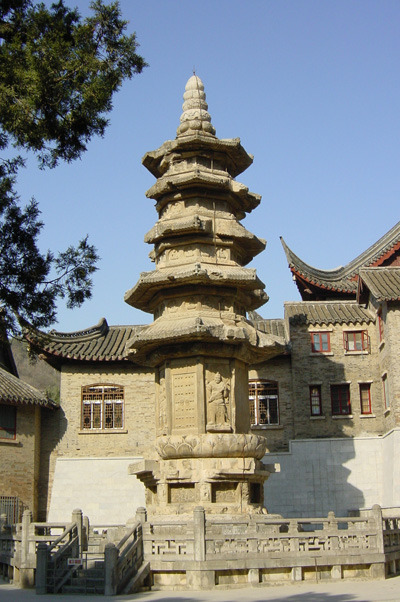
Sarira Pagoda.
Reliefs are carved on the exterior walls. On the base, there are various reliefs of the Buddha; also dragons, phoenixes, birds and flowers. On the body of the pagoda, there are carvings of the Heavenly Kings (four Buddhist gods who watch over the four cardinal points of the world), the Wenshu Buddha (Manjusri, the Buddha of Wisdom), and Puxian Buddha (Bodhisattva of Universal Benevolence) riding an elephant.

Base of the pagoda.

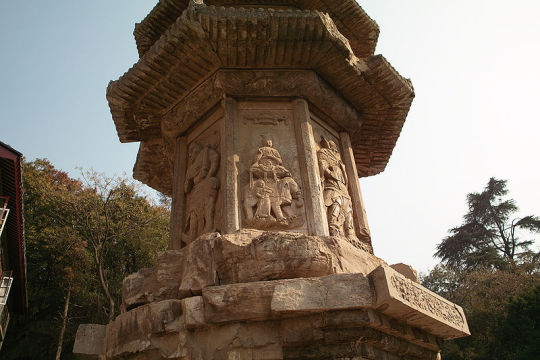

Carvings on the main body.
On each storey, there is a shrine with a Buddha. The base and finial are richly decorated with lotus motifs; the lotus is part of the imagery of the “Pure Land” school of Buddhism.
The Sakyamuni Pagoda was built in 1056, during the Liao Dynasty (907-1125), which ruled present-day Mongolia, part of the Russian Far East, northern Korea, and northern China. It was built by Emperor Daozong, who took the throne in 1055, and built on the site of his grandmother's family home. It is located on the central point of the Fogong Temple's main north-south axis (a common choice of location before the 700's).


The temple was built 85km south of Datong (the Liao Dynasty capital) in Shanxi province. It was originally called Baogong Temple, and was renamed Fogong Temple in 1315, during the Yuan Dynasty. During the Jin Dynasty (1115-1234), its grounds were said to be massive, but it declined during the Ming Dynasty (1368-1644).

Liao Dynasty (1025).
The pagoda is the tallest wooden building in the whole of China, and is the oldest-existing pagoda to be built entirely of wood. It is 67.3m tall – it stands on a 4m-tall base, and the steeple is 10m tall.
It has 54 different types of bracket sets (the most for any Liao Dynasty building), but this isn't noticeable from a distance, as its structure has a high level of harmony and unity. There is a mezzanine level between each outer storey.

Dougong of the pagoda.
From the outside, the pagoda seems to have only 5 stories, and the ground floor seems to have two sets of rooftop eaves. Actually, there are 9 stories inside, as indicated by the pagoda's exterior pingzuo (terrace balconies). [I'm not sure if these are the same as the mezzanine levels.] The lower set of rooftop eaves on the ground floor covers the skirting verandah.


The lowest set of eaves is supported by a ring of columns; there are also support columns inside. The pagoda is named because of the 11m-high statue of the Buddha Sakayumi on the ground floor. There is an ornate zǎojǐng (cassion) above its head, and also one zǎojǐng carved into the ceiling of each storey. The pagoda has a hexagonal base plan, but is 8-sided.
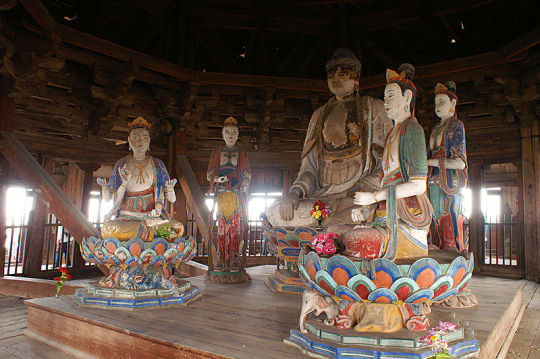
Ground floor.
A zǎojǐng (meaning literally “algae well”) is also called a cassion, cassion ceiling, and spider web ceiling. It is a feature of East Asian architecture, found usually in the ceilings of temples & palaces, and usually in the centre, right above the main throne, seat or religious figure (here, it is the statue of the Buddha). Usually, it is a sunken panel set into the ceiling, often layered & richly decorated. Circles, squares, hexagons, octagons, and combinations of those shapes are common.
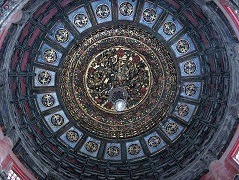
Cassion in the Forbidden City.
The Beisi Pagoda (also called the North Temple Pagoda) is located in the Bao'en Temple in Suzhou. The original pagoda was built in 1153, during the Song Dynasty (960-1279); the Buddhist monk Dayuan was in charge of its patronage and construction. The pagoda burned down near the end of the Song Dynasty, and was rebuilt during the Ming Dynasty (1368-1644). This is the pagoda that we have today.
It has an octagonal base, and is 76m tall. There used to be eleven stories, but it was damaged at some point and now there are only nine. It has double eaves and flying corners. The base and outside walls are made of brick, and the balustrades are made of stone. However, because it is wrapped with wooden cladding (the eaves and banisters are wooden), it looks like a timber structure from the outside.
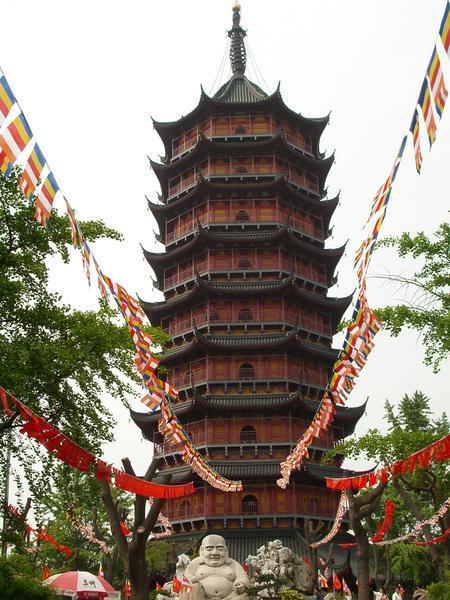

Kaiyuan Temple is located in Quanshou, in Fujian province (south-eastern China). Originally called Lotus Temple, it was built in 685-86, during the Tang Dynasty, and gained its present name in 738. It is a Hindu-Buddhist temple, and one of the few surviving Hindu temples in mainland China.
Two twin pagodas stand to either side of the temple, about 200m apart from each other; they are the highest twin pagodas in China. Renshou Pagoda is on the west side, and Zhenguo Pagoda on the east. They are octagonal plans, and their eave corners turn upwards dramatically, in typical southern style. Their elaborate bracket sets imitate woodwork.

Renshou Pagoda.

Zhenguo Pagoda.

Mahavira Hall (the temple’s main hall).
The first Renshou Pagoda was built in 916, during the Five Dynasties period (907-60), and made of wood. It burned down twice in the Song Dynasty (960-1279), and was rebuilt each time – first with brick, and then with stone. Both pagodas have the same appearance and structure. Renshou Pagoda is 44.6m high, the shorter of the two.
Zhengou Pagoda was built during the Xiantong Period (860-73) of the Tang Dynasty (618-907). It was destroyed in 1155 and rebuilt in 1186; then demolished again in 1227 and rebuilt in stone in 1238. It is 48.24m high, 18.5m in diameter, and each side is 7.8m wide.
It stands on a Sumeru pedestal (a type of substructure named after the mythical Mount Sumeru). This Sumeru pedestal is quite low, and carved with a tier of lotus flowers and a tier of grasses. A celestial guard shouldering the pedestal is carved on each of its eight corners; and its girdle is carved with 39 pictures, including tales about the Buddha, and images of dragons, lions and other animals. The pedestal is surrounded by stone railings, and has five steps cut into each of its four sides.
Four of the pagoda's walls have doors, and the other four have niches for Buddhist statues. On both sides of the doors, images of heavenly kings and celestial guards are carved. On both sides of the niches, images of Manjusri, Samantabhadra & other bodhisattvas are carved, as well as gods and Buddhist disciples. Some carry the sun and moon in their palms; others hold calabashes or sceptres.
Each storey has a verandah on the outside. The corners of each storey are cylindrical, which is rare in ancient architecture.
Inside, there is a central pillar, winding corridors, and staircases. Unlike most winding or vertical staircases in pagodas, these aren't built along the inside of the walls, or along the central pillar. Instead, they are installed through a square hole on one side of the pillar (the pillar is solid and has no compartments). The floors are made up of two layers, with a facing of stone strips, and are supported by stone beams.
The iron steeples are stylistically typical of multi-storeyed pagodas. Iron chains connect them to the corners of their roofs.
The White Dagoba is located at Miaoying Temple, which is also called the White Stupa Temple or White Dagoba Temple. The temple was built in the city of Dadu, and is now in Beijing's Xicheng District. Dagoba is Sinhalese for the Buddhist stupa, and the word shows the building's Tibetan origins.
In 1271, Kublai Khan united the country of China under the Yuan Dynasty (1271-1368), and Tibet also began to come under the Yuan Dynasty's power. To consolidate the relationship between the empire and Tibet (which was mostly under the rule of religious authorities), Kublai Khan ordered the White Dagoba to be built. The architect was Anigo, from Nepal.
The construction lasted from 1271-79. Then, Kublai Khan ordered a temple to be built around it. The area of the temple was 160,000m2, and this was decided by the Emperor firing four arrows in four directions from the top of the White Dagoba. The temple was called Dashengshou Wan'an Temple.
During the Yuan Dynasty, the temple was mostly used as an imperial temple. The governor ordered that all important ceremonies were to be rehearsed here three days ahead of time. When Kublai Khan died, his sacrificial ceremony was held here.
People called Dadu (the capital at the time) and the White Dagoba “Golden City and Jade Dagoba”. The temple was burned down in 1368, but the dagoba survived. In 1457, during the Ming Dynasty (1368-1644), Emperor Tianshun ordered the temple to be rebuilt. However, it was much smaller this time – about 13,000m2 – and it was renamed Miaoying Temple.

The current temple.
In the late Qing Dynasty (1644-1911), the Miaoying Temple was one of the most well-known locations for temple fairs, hence the saying, “August 8th, time to visit the white dagoba”. On October 25th (according to the lunar calendar), there was a custom of lamas walking around the dagoba, chanting scriptures and playing music. This is the anniversary of the dagoba's completion.
The Miaoying Temple consists mostly of the White Dagoba and four halls (which store Buddhist statues, classical Buddhist scriptures, five Buddhist crowns, flowery cassocks, fabrics, and other artifacts). The golden Dagoba Longevity Statue is the most famous – it is 5.4cm tall, and has over 40 rubies. The bronzy [?] Kwan-yin Boddhisattva Statue (with 1000 hands & eyes) is also very famous. These current halls are from the Qing Dynasty.
The White Dagoba is north of the Miaoying Temple. It has a 3-layered base, and the body looks like an upside-down ice-cream cone. On top of the body is a thick wooden base, upon which is a solid bronze canopy. This is supported by strong iron chains. On the very top is another small stupa.
It is made of white-washed brick, and is 48m tall. The borders of the dagoba [or the stupa on top?] are adorned with small Buddhist characters and statues, and wind chimes. This dagoba is the earliest and largest Tibetan dagoba in China.

The White Dagoba.
#book: a concise history of architectural styles#history#architecture#china#ancient china#tibet#chinese architecture#chinese pagodas#northern wei dynasty#liao dynasty#yuan dynasty#song dynasty#ming dynasty#tang dynasty#qing dynasty#quanshou#songyue pagoda#songyue monastery#sarira pagoda#qixia temple#sakyamuni pagoda#fogong temple#beisi pagoda#bao'en temple#kaiyuan temple#renshou pagoda#zhenguo pagoda#white dagoba#miaoying temple
34 notes
·
View notes
Photo

斯里兰卡佛牙节 "Buddha to pitch" 佛牙节在斯里兰卡中部山区佛教圣地康提举行,是对供奉在康提圣牙寺的释迦牟尼的佛牙舍利表示敬意。一年一度的佛牙节是佛教最盛大的节日之一。“佛牙节”,即把佛牙舍利塔放在大象背上,巡游全城,让民众分享佛牙荣光的活动。 The tooth festival is held in kandy, a buddhist shrine in the mountains of central Sri Lanka, to honor sakyamuni's tooth relic, which is enshrined in kandy's holy tooth temple. The annual Buddha's tooth festival is one of Buddhism's biggest festivals. The day of the tooth, in which the Buddha's tooth pagoda is placed on the back of an elephant, cruises the city for the public to share in the glory of the tooth. #斯里兰卡 #斯里兰卡旅游 #srilanka #srilankatravel #srilankatrip #photography #photowall #photoshop #colombo (在 Kandy City Centre - KCC) https://www.instagram.com/p/B_As4avH_HD/?igshid=f1wch7qf89zk
0 notes
Text
youtube
来迎阿弥陀三尊佛 総高8.45m 製作 念佛宗総本山 佛教之王堂 本堂 The Buddhist Art & Architecture of Nenbutsushu 仏教美術 兵庫県加東市
堂内
金箔二重貼り、六手先総詰組、屋根葺面積226.2㎡、総数16,000枚の瓦を使用した宮殿(高さ19m、幅19.98m、奥行12.36m)、 その中に在して、大慈悲の光明にて十方世界を照らすが如く輝きわたる本尊阿弥陀三尊佛は、中華人民共和国、工芸美術大師・佘國平佛師制作の総高8.45mの木彫佛像です。
全世界 仏教徒の聖地 「佛教之王堂」念佛宗 総本山 無量壽寺 仏教美術の宝箱 故タイ法王猊下 世界各国の仏教最高指導者 並びに カンボジア王国 故ノロドム・シアヌーク国王陛下の御聖骨がお祀りされている寺院です。
佛教之王堂は佛法に基づいて建立され 建物全ての部位に、仏縁を結ぶ教えが込められています
伽藍工事全体、およそ7年間で10,524点の彫刻、450,173点を超える彫金が製作されました。
The Royal Grand Hall of Buddhism - Nenbutsushu Buddhist Sect of Japan The sacred place for all Buddhists in the world
The Royal Grand Hall of Buddhism 仏教美術の宝箱 Buddhist Art
https://buddhistart18.com https://www.tumblr.com/nenbutsushuart
念佛宗公式 Official
https://muryojyu.com
Buddhism has its origin in IndiaBuddhist cultures of China, Korea, and Japan are represented hereat the Royal Grand Hall of Buddhism. It is the first construction of an authentic full-scale Buddhist temple since the erection of the main temple of Obakushu Buddhist Sect in 1661.A total of roughly 3.5 million people joined forces to construct the Royal Grand Hall of Buddhism and completed the entire temple in only seven years without even a single accident.The Royal Grand Hall of Buddhism, in its vast precincts of over 180 hectares, has the Front Gate, the North Gate, the South Gate, the Main Gate, the Washstand, the Ksitigarbha Hall, the Prince Shotoku Hall, the Five-story Pagoda, the North Bell Tower, the South Bell Tower, the Main Halls including the Amida Hall and the Sakyamuni Hall and the Avalokitesvara Hall, the Sutra Hall, the Merit-transference Hall, the Okunoin Hall, the International Buddhist Conference Hall, the Sangha Hall, and the Main Building. All the buildings are decorated with 10,524 sculptures and statues and more than 450,173 metal carvings.
#念仏宗#念仏宗無量寿寺#nenbutsushu#the royal grand hall of buddhism#buddhist temple#仏教美術#art#buddhist statue#仏像#釈迦#woodcarving#Youtube
1 note
·
View note
Text
TURISIAN.com - Sobat Turisian, ada nih destinasi keren banget buat dijelajahin! DEWI TARI, lokasinya di Desa Rebo, Kecamatan Sungailiat, Kabupaten Bangka, Provinsi Kepulauan Bangka-Belitung (Babel) Gampang banget buat sampe sini, jalanannya bagus dan deket sama kota. Kalo dari bandara juga ga butuh waktu lama, cuma sekitar 30 menit aja pake mobil. Nah, di DEWI TARI ada 4 spot wisata keren yang bisa kamu kunjungin. Yaitu wisata bahari, wisata buatan, wisata religi, dan wisata budaya. Fasilitasnya juga oke, ada homestay, paket wisata, masyarakatnya ramah, dan aman. Bisa jadi tempat yang pas buat kamu buat nge-eksplor dan ngerasain pengalaman yang ga bakalan terlupakan! BACA JUGA: Batik Habangka Akhirnya Lolos ke Ajang API, Gini Ceritanya Wisata baharinya juga gak kalah asik, terutama Pantai Takari. Pantainya punya pemandangan yang cakep, pasirnya putih banget, dan ada pohon cemara yang rapi banget. Cocok buat buat melepas penat dan ngerileksasi diri. Di pantai ini juga ada banyak kerang, jadi kamu bisa ikutan nyari kerang dan ngerasain kegiatan Nyakar yang tradisional banget. Ada juga Pantai Cemara yang lahan pasca tambangnya dikelola dengan baik, dan Pantai Batu Ketak yang punya ikon Morcusuar peninggalan Belanda. Kalo kamu suka tempat buatan, ada destinasi Mutiara Timur yang unik banget. Tempat ini dulunya kolong bekas penambangan timah yang diubah jadi tempat wisata. BACA JUGA: Ada Bunga Bangkai Bermekaran di Kebun Raya Cibodas Berbagai jenis tanaman hias [caption id="attachment_16366" align="alignnone" width="800"] Pagoda Nusantara terletak diatas ketinggian 356 Mdpl berada di Desa Rebo, Kabupaten Bangka. Foto: Dok.Kemenparekraf[/caption] Sekarang kolong-kolongnya diisi ikan koi dan ikan nila, dan lahan sekitarnya ditanamin berbagai jenis tanaman hias. Jadi bisa buat jadiin spot buat selfie yang keren! Buat kamu yang pengen wisata religi, bisa kunjungin Puri Tri Agung. Tempat ini melambangkan tiga ajaran Tri Darma yang terdiri dari Konfutse (Confucius), Budhisme (Sakyamuni), dan Taoisme (Lao Tzu). Bangunannya megah banget, dan pemandangannya juga indah banget karena deket sama pantai. Selain itu, ada juga Pagoda Nusantara sama Kelenteng Desa Rebo yang asik buat dikunjungin, terutama pas festival budaya. Oh iya, ada juga kegiatan budaya yang seru banget di DEWI TARI! Misalnya, Festival Chit Ngiat Pan atau yang lebih dikenal dengan Sembahyang Rebut. BACA JUGA: Indahnya Pesona Alam Danau Pading Bangka Tengah Biasanya dirayakan setiap tanggal 15 Bulan 7 kalender China. Acaranya buat menghormati arwah para leluhur dengan cara memberikan persembahan berupa hasil pertanian di depan altar Thai Se Ja. Dimana, bentuknya kayak patung raja akhirat setinggi 6 meter. Ada juga kegiatan Peh Cun yang seru, bisa coba makan kue bacang atau melempar kue bacang ke laut. Buat umat muslim, ada juga kegiatan Nganggung buat mempererat silahturahmi antara sesama umat muslim. Lengkap kan? BACA JUGA: Liburan dulu di Pantai Batu Kapur Bangka Selatan! [caption id="attachment_16367" align="alignnone" width="800"] Wisatawan juga bisa menelusuri aliran sungai dengan perahi kano di Dewi Tari. Foto: Dok.Kemenparekraf[/caption] Tempat Kuliner Di sekitar kawasan wisata Dewi Tari, terdapat banyak tempat kuliner yang bisa dicoba. Berikut adalah beberapa di antaranya: Warung Makan Pak Eko: Warung makan yang terkenal dengan masakan khas Bangka, seperti mie lendir, luti gendang, dan nasi kuning. Rumah Makan Bahari: Menyajikan menu makanan laut yang segar dan lezat, seperti kepiting saus padang, ikan bakar, dan udang goreng mentega. Depot Anugerah: Menyajikan aneka kuliner Indonesia, mulai dari nasi uduk, soto, ayam penyet, hingga seafood. Kedai Kopi Bangka Coffee: Tempat yang cocok untuk ngopi sambil menikmati pemandangan pantai Takari. Menyajikan kopi lokal dan aneka snack ringan. BACA JUGA: Benteng Toboali, Peninggalan Bersejarah di Tanah Bangka yang Dibangun 1825 5. RM Sari
Laut: Warung makan yang menyajikan masakan laut segar, seperti kepiting saus padang, udang goreng mentega, dan sate cumi. 6. Warung Nasi Bungkus: Tempat yang cocok untuk mencari nasi bungkus atau nasi kotak dengan pilihan lauk-pauk yang variatif, seperti ayam goreng, tempe goreng, dan tahu isi. 7. Kedai Makanan Batu Bedaun: Tempat yang menyajikan aneka kuliner khas Bangka, seperti mie celor, mie ayam, dan nasi goreng. 8. Warung Makan Sinar Harapan: Menyajikan menu makanan Indonesia yang lezat dengan harga terjangkau, seperti nasi goreng, mie ayam, dan ayam bakar. Pastikan untuk mencicipi beberapa kuliner di atas saat berkunjung ke Dewi Tari untuk merasakan pengalaman kuliner yang khas di Bangka. ***
0 notes
Text
The Sakyamuni Pagoda of Fogong Temple, built in 1056AD, Liao dynasty, tallest and oldest fully wooden pagoda in China. It is said that the best time to visit is during summer where you can see hundreds of swallows flying around it. (Shanxi, China) via /r/China

The Sakyamuni Pagoda of Fogong Temple, built in 1056AD, Liao dynasty, tallest and oldest fully wooden pagoda in China. It is said that the best time to visit is during summer where you can see hundreds of swallows flying around it. (Shanxi, China) https://ift.tt/2RhsBTf Submitted January 22, 2020 at 01:43AM by i_reddit_too_mcuh via reddit https://ift.tt/2NOp0tT
0 notes